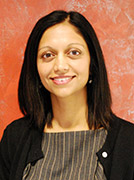CV: Dr. Elizabeth David
An associate scientist in physical sciences and the Odette Cancer Research Program at Sunnybrook Research Institute sits down to answer a few questions from Alisa Kim.
Bio basics: An associate scientist in physical sciences and the Odette Cancer Research Program at Sunnybrook Research Institute (SRI). Graduated from medical school at the University of Toronto in 1997 and completed her fellowship in interventional radiology at St. Michael's hospital, Toronto. Has worked as an interventional radiologist at Sunnybrook since 2004.
What is your research focus?
We're trying to see how effective a new machine from Philips is in treating fibroids using high-intensity focused ultrasound ablation, which Dr. Kullervo Hynynen [director of the physical sciences platform at SRI, and a pioneer of the technology] has been involved in for many years. With his help, we're trying to see if we can tweak the system to get the best ablation possible for patients with fibroids. We would like to achieve symptom control with significant volume ablation and shrinkage of the fibroid, but in a manner that creates minimal discomfort for the patient. Most of our patients are able to return to work within 48 hours after the procedure. Our embolization patients certainly do not have such a speedy recovery.
That must excite you.
Absolutely. This is the next frontier, where you're moving to doing things through external beams and doing it in a way that's so minimally invasive that you have very little discomfort at the end. Not everything will be amenable to that, but this is another technique where we can basically cook the tumour and get the same effect.
What are the next steps in this research?
We're finishing Phase 1 of the trial, which has 15 patients. We're starting Phase 2 in November or December with 150 patients, pending ethics approval, across multiple sites in North America. With other transducers and other machines, high-intensity focused ultrasound has been proven to be very safe. So it isn't so much a question of safety, it's the efficacy. We're trying to see if this is an effective treatment for fibroids. Is it equivalent to embolization? Is it equivalent to surgical techniques?
If you weren't in medicine, what would you be doing?
I would probably be in engineering. As a radiologist, I'm in a position where I directly see how medical technology improves the quality of patients' lives. I've always been impressed at how important biomedical engineering is within the field of imaging and medicine as a whole. I'm amazed at how fast things have progressed within the course of my training.
What do you enjoy doing outside of work?
I have a four-year-old and a one-year-old. They are the focus of my life right now. It's all about swimming lessons and skating lessons and birthday parties. That's what we do at home. We run around after them.






